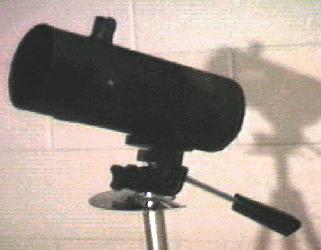USING THE TELESCOPE
===========================
Once you have your tube cut to the best size,
you will mount your mirror with some tape glue just to get a
balancing point on a Tripod or whatever you will use as a telescope
holder. As you get a point for mounting your scope, concider
that you will be moving the entire
Telescope up and down ALOT! and will have need for it to be able
to "track" an object.
Some objects in space move faster than others
because of the Earth's Rotation and relation to the Planetary
Bodies. In other words; things will move fast as you focus. As
soon as you get an object in view (and focus), it will begin
to move out of view as the Earth rotates!
Your tripod or scope holder should let you
move the entire telescope atleast 90' degrees up, and 180' degrees
in either direction, at any time and even all the time!
The movement of your telescope can be had
automatically by the use of a new "Pan & Tilt"
mounting system that lets you control it from a computer and
it's view screen
program. This new software and USB interface is now available
with a Micro-CAM and all the motor hardware you'll need to get
started taking your own "Astrophotos".
Astrophotography is not possible on all telescopes,
and can be rather challenging to an ametur or beginner. Some
of those briliant and colorfull images you see from
Hubble and the other 200" inch telescopes used by the local
University are not exactly possible with this kit.
The possibilities to you getting images from
space on your website or in print is mostly considered as a Novice
or more advanced feature, and is mainly accomplished by using
a 35mm camera "piggy backed" on top of the telescope
and attached to the eyepiece. The film is then exposed for several
minutes, even hours of a "tracked" steady image.
With the new remote controlled mounting unit
& a USB port, you can control your new Telescope or TeleCam
from software operated on your computer, or even across the Internet!
You will have to buy the Software, and if you use the link below,
you will immediately recive a $15 dollar voucher good to the
purchase of any of the products. (enter your email addy then,
look at the Hot Deals link for mounts)
 With the new Pan/Tilt mounts & remote software,
you can get
With the new Pan/Tilt mounts & remote software,
you can get
some super images on your computer to upload to a friend
or website in minutes. Just checkout the Hot Deals section!
After the mounting point has been found on
your scope, you will need to make a "position marker"
or angle meter such as a cheap little device known as a "Protractor".
Get a couple of them, and make sure they are clear or almost
clear.
You can buy a protractor at your nearest Walmart
or school supply store or just about any where for about $1.00
one dollar. This will mount at the center of your scope or balancing
point, and used to help you find and keep track of your nightly
viewing habbits.
You will also need to make one for the left-right
movment of your scope as you will use it for making notes to
a possition of a Star or other object you intend to record.

I have used the cheap little protractor to
mark a couple CD-ROMs on the Telescope as my Angle-Meter or known
in the professional world as the "Equatorial Possition"
and mark the center as North.
When beginning in Astronomy, one may fear
the unknown, and begin to think that all of it is too much; but
thats not true. All you have to have to begin is a couple good
maps
or "Starcharts" and a handy little software program
like "Sky Globe". (see Downloads)
This DOS program will help you learn the basics
of charting and learning the Constellation plus finding some
of the popular and most common stars out there in the night sky.
Once you have the knowledge to finding the
local planets and stars at ANY TIME during the night, you'll
be able to quickly and effectivly put this telescope to work.
This Telescope is so light and easy to use,
you can set it up almost anywhere and in seconds you can have
images on a TV, VCR or computer with the use of a micro-cam,
or the new Ninja unit.
If you don't have the dollars for the 'wireless'
mounts or for the new mega-pixel cams, then the use of one of
the older 'quick-cams' or 'webcams' will do fine for now, but
you will have to control the scope manually :)
Using your new telescope will be great fun
for everyone, and will be with you a long time. Make sure you
design it well and keep it 'dust-free'. Store this in a plastic
bag or large box in your closet, or just keep it covered when
not in use.
The Main Mirror should always be kept free
of dirt or dusty areas, (keep it covered or closed when not using
it) and not exposed to small hands or fingers. Always be sure
not to directly look at the Sun during the day if you intend
to use this for daytime field viewing or sporting events.
 Good Luck! And Happy Views!
-CopyCat
Good Luck! And Happy Views!
-CopyCat
|
